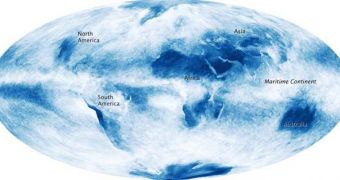Scientists controlling space-based analysis instruments aimed at the Earth have known for a long time that the outlines of the Earth's continents can easily be distinguished from orbit from the outlines that they project onto clouds. This may be owed to the significant differences that appear between cloud coverage of the land and the seas, experts believe. The phenomenon is known as “cloud fracture,” or the fracturing of clouds, and a view of it, captured last month, was recently made available by the American space agency NASA, LiveScience reports.
The set of advanced measurements that was used to produce the photograph was collected from the NASA Terra satellite database. The images were snapped with the Moderate Resolution Imaging Spectroradiometer (MODIS) instrument, which illustrates cloudless skies in blue and heavily clouded areas in white. Intermediary levels of coverage are also represented with various colors ranging between the main two. The investigators operating the instrument highlight the fact that the most dramatic differences in cloud coverage (boundaries) naturally appear around continents, or large land masses that are surrounded by oceans.
Such is the case with the entire African continent, which is surrounded by the Mediterranean Sea to the North, the Atlantic Ocean to the West, the Southern Ocean to the South, and the Indian Ocean to the Southeast. The Arabian Peninsula and Greenland also projected similar boundaries in the clouds surrounding them. In humid regions, it would appear that the differences between the land- and sea-based cloud covers drop considerably, NASA announces in a statement. This is most obvious in west-central Africa, especially over the humid tropical forests.
Clouds are a very important part of our planet's natural cycle. In addition to producing rain and snow, they can also exert a strong influence on the climate of a certain region, depending on the altitude they form at, on their type, and also on the time they form. Additionally, these formations also reflect a large portion of incoming sunlight back into the upper atmosphere, protecting (or depriving) the land below of heat. Still, they can also keep a region warm, by preventing heat emanating from the ground from escaping into the upper atmosphere and beyond. For all these purposes, keeping an eye on their behavior can provide scientists with indications on the health of the atmosphere and related energy systems.

 14 DAY TRIAL //
14 DAY TRIAL //